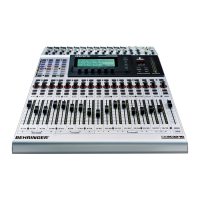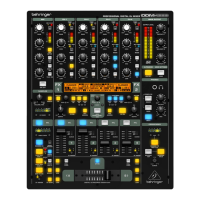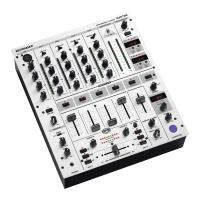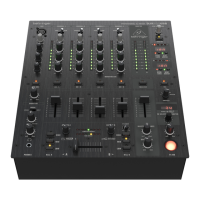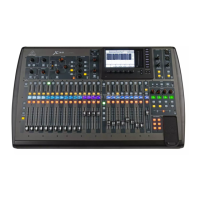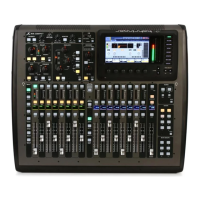19
3.2 CHANNEL PROCESSING switches
Use the CHANNEL PROCESSING switches (PROC) to display
the menu pages for the channel processing functions in the
selected channel strip (EQ, gate, compressor/limiter, phase/delay
or routing). Many of these menus have more than one page. To
scroll through these pages, use the PREVIOUS and NEXT
switches or press one of the CHANNEL PROCESSING switches
repeatedly.
3.3 A/B function
The processing menus provide an A/B function that helps you
compare two different settings. Each time you recall a menu
page (selection of a new channel, or coming from another menu
page), setting A will always be selected, and both A and B have
the same parameter settings. Now, you can edit one of the two
pages (A or B) and switch between them to compare their
settings. When you quit a menu page (selection of another
channel, fader bank or menu page), the settings of the currently
inactive page will be erased.
3.4 Equalizer
3.4.1 EQ menu page
The EQ page of the EQUALIZER menu (which can be accessed
by pressing the EQ switch in the switch bank) allows you to edit
the powerful equalization functions of your DDX3216. Each
channel has a complete, fully parametric 4-band digital EQ with
tunable frequency, filter quality (Q) and boost/cut. All bands can
be tuned from 20 Hz through 20 kHz and provide a boost/cut of
max. 18 dB. The low band can be configured as a low-cut (LC)
or low-shelving filter (LSh), the high band as a high-cut (HC) or
high-shelving filter (HSh). Simply press the Q control (master
controller 4) once or twice respectively. Pressing this controller
a third time will reset the filter to its fully parametric configuration.
Fig. 3.3: EQ page in the EQUALIZER menu
Select the band you wish to edit by turning or pressing the left
controller. Then, turn the second controller to adjust the frequency.
Press this controller to reset the frequency to its default value.
The GAIN value (boost/cut) for the selected band can be edited
with master controller 3. Press this controller to set the GAIN to
“0”. Controller 4 determines the Q factor (filter quality). Controller
5 controls the A/B function, so that you can easily compare two
different settings. The parametric EQ can be switched IN or OUT
by turning or pressing the controller located on the far right.
When the EQ is switched on, the graphic display on the right
gives you a visual indication of the current EQ setting, including
the high-pass filter. The broken vertical line shows the center
frequency of the currently selected band. When the EQ is out,
the graphic will show a flat response. The IN/OUT and A/B
functions on this page are effective only on the equalizer of the
selected channel. The HIGH PASS menu page has its own A/B
and IN/OUT functions.
3.4.2 HIGH PASS menu page
In addition to the parametric equalizer, each channel has a
dedicated high-pass or low-cut filter, which is controlled on a
separate menu page. The high-pass filter has a slope of
6 dB/oct., and can be tuned from 4 through 400 Hz. It is mainly
used to eliminate unwanted low-end noise, such as rumble,
microphone handling noise, etc.
Fig. 3.4: HIGH PASS page in the EQUALIZER menu
This menu page has its own A/B and IN/OUT functions, which
work independently of those found on the EQ menu page. The
high-pass filter is placed directly after the input, i. e. it is “wired”
before the equalizer in the signal path.
3.4.3 EQ LIBRARY menu page
The EQ LIBRARY menu page offers a selection of EQ presets
with descriptive names. Of course, you can name and store
your own presets as well. Use the control below the preset list
to select a preset, then press RECALL to load it.
Fig. 3.5: LIBRARY page in the EQUALIZER menu
Loading an EQ library will change the contents of both the EQ
and HIGH PASS menu pages, and overwrite the settings A and B.
3.4.4 EQ parameters
Frequency is measured in Hertz (Hz = oscillations or cycles
per second). In musical terms, frequency corresponds to pitch,
i. e. the higher the frequency, the higher the pitch. The interval of
one octave corresponds to a doubling of frequency. The range
of human hearing is from approximately 20 Hz through 20 kHz (=
20,000 Hz). The musical note of middle C corresponds to a
frequency of 256 Hertz, the lowest note on a piano is A
2
(double-
contra octave), the highest note is c
5
. The lowest pedal tones of
a large church organ are around 20 Hz.
Most musical signals consist not only of a single frequency,
but of a combination of multiple frequencies. Equalizers allow
you to adjust the amplitude relationships between the various
frequencies of a specific sound.
In combination with the filter quality (Q), the frequency para-
meters determine which frequency range is processed by the
equalizer. The Q or QUALITY parameter controls the filter
bandwidth, i. e. the lower the filter quality, the more frequencies
are processed. In order to shape the color of a sound with an
EQ, you usually need to use a relatively low filter quality (approx.
0.3 to 2). With a high Q value, on the other hand, you can
specifically process very narrow frequency bands, for example
to remove problematic frequencies or tones, without affecting
the remaining frequencies. Additionally, certain special effects
can be created.
The GAIN parameter of a filter determines whether a specific
frequency range is emphasized or attenuated. Gain is measured
in decibels (dB), a logarithmic unit of measurement that compares
two values. Without going into mathematical details here, it should
be mentioned though that a boost of 6 dB equals a doubling of
amplitude, while an attenuation of 6 dB cuts the amplitude by
half. The gain range of +/- 18 dB provided by the EQs of your
DDX3216 means that you can boost or cut a certain frequency
range to 8 times its original value.
In the bottom band of the EQ, reducing the filter quality beyond
its minimum value gives you two further options: low-cut and
low-shelf, which are effective on all frequencies below the
selected cutoff frequency.
3. DIGITAL CHANNEL PROCESSING

